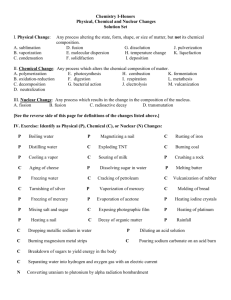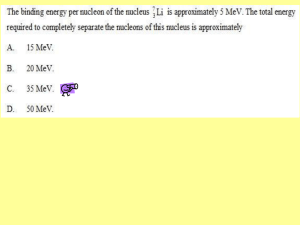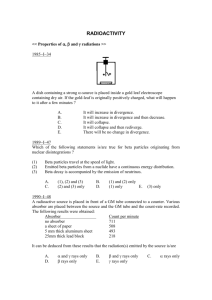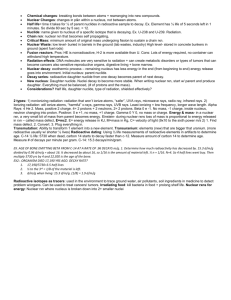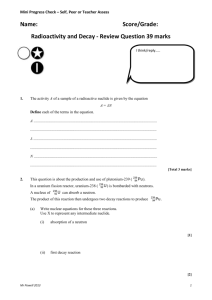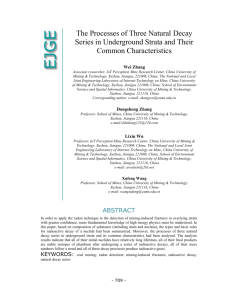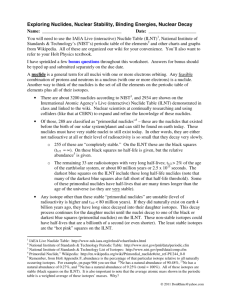Practice Problems
advertisement
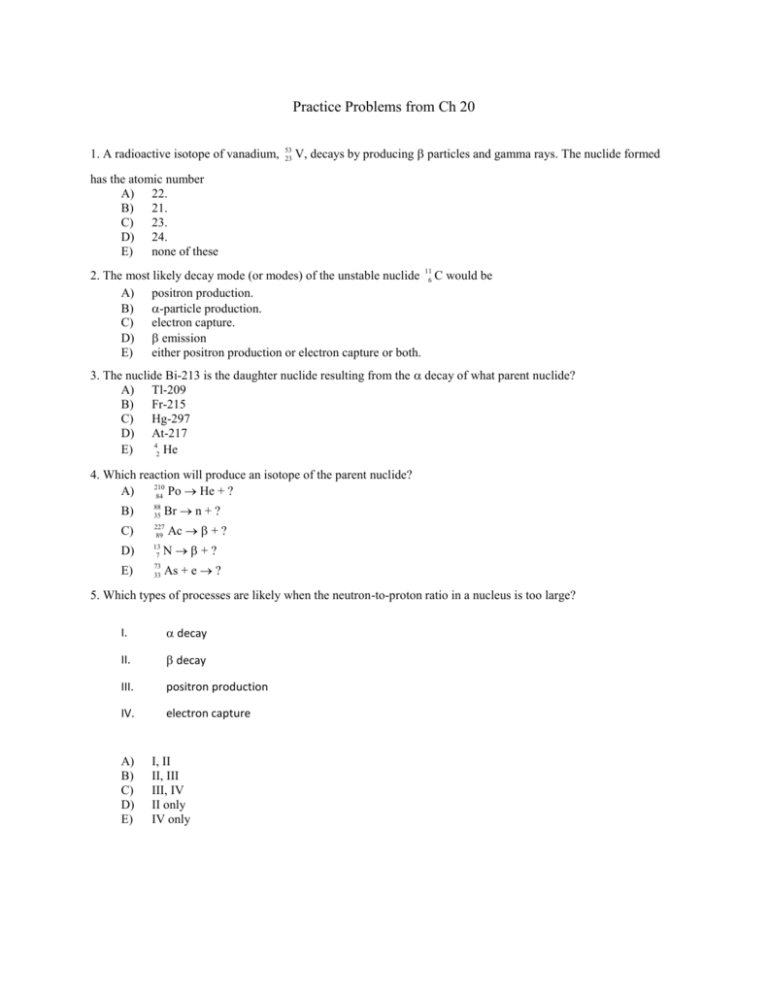
Practice Problems from Ch 20 1. A radioactive isotope of vanadium, 53 23 V, decays by producing particles and gamma rays. The nuclide formed has the atomic number A) 22. B) 21. C) 23. D) 24. E) none of these 2. The most likely decay mode (or modes) of the unstable nuclide 116 C would be A) positron production. B) -particle production. C) electron capture. D) emission E) either positron production or electron capture or both. 3. The nuclide Bi-213 is the daughter nuclide resulting from the decay of what parent nuclide? A) Tl-209 B) Fr-215 C) Hg-297 D) At-217 4 E) 2 He 4. Which reaction will produce an isotope of the parent nuclide? 210 A) 84 Po He + ? Br n + ? B) 88 35 C) 227 89 D) 13 7 N+? E) 73 33 As + e ? Ac + ? 5. Which types of processes are likely when the neutron-to-proton ratio in a nucleus is too large? I. decay II. decay III. positron production IV. electron capture A) B) C) D) E) I, II II, III III, IV II only IV only 6. The nuclide 232 90 Th is radioactive. When one of these atoms decays, a series of - and -particle emissions occurs, taking the atom through many transformations to end up as an atom of emitted in converting A) 6 B) 8 C) 2 D) 214 E) 4 232 90 Th into 7. Electron capture transforms A) 40 20 Ca B) 40 18 Ar C) 4 2 D) 40 19 K– E) 39 20 Ca 40 19 208 82 208 82 Pb. How many particles are Pb? K into what nuclide? He 238 8. The stable nuclide 206 82 Pb is formed from 92 U by a long series of and decays. Which of the following nuclides could not be involved in this decay series? A) Pa-234 B) U-239 C) Po-218 D) Tl-210 E) Rn-222 9. What is the most likely decay for the Fe-59 nucleus? A) decay B) positron emission C) decay D) -ray emission E) proton emission 10. Which of the following balanced equations is labeled incorrectly? 4 211 1 A) alpha emission: 209 83 Bi + 2 He 85 At + 2 0 n B) fusion: 12 H + 12 H 13 H + 11 H C) bombardment: D) E) 239 94 beta production: Pu + 10 n 239 92 alpha production: U 230 90 239 93 Th 240 95 Am + Np + 226 88 Ra + 0 1 0 1 e e 4 2 He 11. When the U-235 nucleus is struck with a neutron, the Zn-72 and Sm-160 nuclei are produced, along with some neutrons. How many neutrons are emitted? A) 2 B) 3 C) 4 D) 5 E) 6 12. The rate constant for the beta decay of a particular radioactive element is 2.78 10–2/day. What is the half-life of this nuclide? A) 4.01 10–1 days B) 1.80 101 days C) 3.60 101 days D) 2.49 101 days E) 7.19 102 days 13. What is the number of half-lives needed for a radioactive element to decay to one-eighth of its original activity? A) 1 B) 2 C) 3 D) 0 E) 4 14. A 0.20-mL sample of a solution containing 13 H that produces 3.7 103 cps is injected into the bloodstream of an animal. After circulatory equilibrium has been established, a 0.20-mL sample of blood is found to have an activity of 20 cps. Calculate the blood volume of the animal. A) 18 mL B) 37 mL C) 11 mL D) 180 mL E) none of these 15. Radioactive elements decay via first-order kinetics. Consider a certain type of nucleus that has a rate constant of 2.3 10–2 h–1. A sample contains 6.8 108 radioactive nuclides. Calculate the time required to reduce that number to 2.0 108. A) 2.3 101 h B) 2.1 1010 h C) 5.3 101 h D) 6.8 10-1 h E) 7.8 h 16. The number of a certain radioactive nuclide present in a sample decays from 2.9 102 to 6.2 101 in 25 minutes. What is the half-life of this radioactive species? A) 2.6 minutes B) 6.2 10-2 minutes C) 1.1 101 minutes D) 1.6 101 minutes E) 8.1 101 minutes 17. The Cs-131 nuclide has a half-life of 30 years. After 120 years, about 3 g remain. The original mass of the Cs131 sample is closest to A) 30 g B) 40 g C) 50 g D) 60 g E) 70 g 18. The half-life of 90Sr is 28 years. How long will it take for a given sample of 90Sr to be 79% decomposed? A) 2.7 101 years B) 9.5 years C) 6.3 101 years D) 3.5 102 years E) 4.1 years 19. The half-life for electron capture for 4.5 billion years old? A) 0.091 B) 11. C) 10 D) 0.10 E) 0.36 40 19 K is 1.3 billion years. What will be the 1940 K / 40 18 Ar ratio in a rock that is 20. The Br-82 nucleus has a half-life of about 1.0 103 minutes. If you needed at least 1.7 g of Br-82 and had ordered 33 g of NaBr (assuming all of the Br in the NaBr was Br-82), how many days could you wait for delivery? A) 1.2 days B) 3.0 days C) 3.9 days D) 2.7 days E) 3.2 days 21. A sample of wood from an Egyptian mummy case gives a 14C count of 9.0 cpm/gC (counts per minute per gram of carbon). How old is the wood? (The initial decay rate of 14C is 15.3 cpm/gC, and its half-life is 5730 years.) A) 1.9 103 years B) 3.0 103 years C) 4.4 103 years D) 4.9 103 years E) 3.4 103 years 22. Which statement is true about the following reaction? A) B) C) D) Energy is absorbed in the reaction. Energy is released in the reaction. No energy change is associated with the reaction. Not enough information is given for us to determine the energy change. 23. Calculate E in kilojoules per mole for the reaction 230 4 1 90 Th 2 He + 1 Ra Atomic masses: A) B) C) D) E) 230 90 Th = 230.0332, 42 He = 4.00260, 11 Ra = 226.02544. –4.6 108 kJ/mol –2.4 106 kJ/mol 0 +2.4 106 kJ/mol +4.6 108 kJ/mol Use the following to answer questions 24-25: Iron-56, 56 26 Fe, has a binding energy per nucleon of 8.79 MeV. (1 MeV = 1.60 10–13 J) 24. Determine the amount of energy needed to "decompose" 1 mol of iron-56 nuclei. A) 3.47 1011 J B) 4.74 1013 J C) 8.90 1011 J D) 1.13 1014 J E) 7.75 1013 J 25. Determine the difference in mass between 1 mol of iron-56 nuclei and the component nucleons of which it is made. A) 9.41 10–6 kg B) 2.43 10–5 kg C) 6.65 10–5 kg D) 5.27 10–4 kg E) 7.21 10–4 kg 26. Which of the following statements is true of the fission of uranium-235? A) The electron is captured by the nucleus, which becomes unstable. B) The products include neutrons. C) The nuclides produced are individually heavier than the uranium nuclide. D) The ultimate nuclides produced are more stable than the uranium nuclide. E) two of these 27. If more than one neutron from each fission event causes another fission event, the fission situation is described as A) critical. B) subcritical. C) supercritical. D) moderated. E) none of these 28. The smallest amount of radioactive material that will support a self-sustained reaction is called the A) molar mass. B) moderator. C) supercritical mass. D) subcritical mass. E) critical mass. ANSWERS: 1. D 2. E 3. D 14. B 15. C 16. C 26. E 27. C 4.B 17. C 28. E 5.D 6.A 18. C 7. B 19. D 8.B 20. D 9. A 10. A 21. C 22. A 11.C 23. A 12. D 24. B 13. C 25. D

